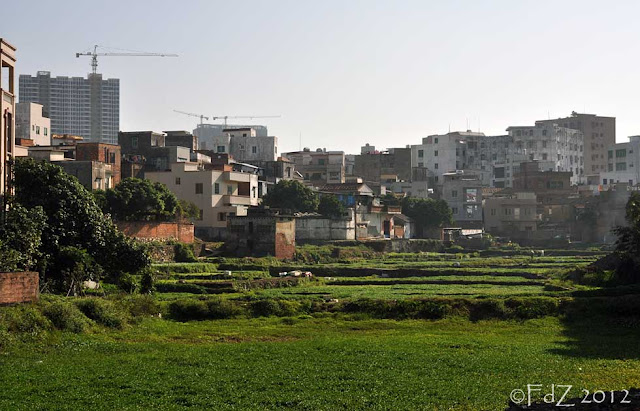In southern China, towns are growing fast and there is often no clear line between urban and rural. One day a few weeks ago, on one of our habitual weekend walks in and around Wuchuan, Guangdong province, my honey and I stumbled on this lone grave, just a few dozen meters from busy city streets.
Wuchuan, Guangdong, 2012
The shape of the grave is rather typical for this area of China, and it's also not at all unusual to see a single grave or a small cluster of graves out in the countryside or mixed in with farm plots, as opposed to a formal cemetery within certain boundaries.
Below you see a closeup of the burial mound with the black stone marker with red characters of the family name at the back.
As we were photographing whatever we thought interesting, this friendly farmer approached us. He eagerly engaged in conversation with my honey (who is of Chinese origin) and part of what follows is what he told us about the grave.
This farmer is a descendant of the Cheuk Clan. The grave was built in 2010 to commemorate the ancestors of this clan from Wuchuan who died anytime from one to two hundred years ago - he wasn't so sure - up to a few generations ago.
Inset into the red brick wall behind him (above) is a complete list of living clan members who contributed funds to the project of rebuilding their ancestors' grave to honor them.
The small grave behind the clan grave is for the servants of the clan who were considered part of the family yet were expected to serve beyond their lives on this earth.
Most important to the living descendants is to place their ancestors in an auspicious spot that will enhance their fortune and welfare in all aspects. The farmer specifically asked whether my honey thought the family had picked a good feng shui spot, to which he answered, "yes, the spot is good, facing a fine view; however, unfortunately, the open view is cut by power lines. That must not be very comfortable for them and could diminish the good effect somehow."
I hope to write more about southern Chinese burial culture and the role
feng shui plays in future posts.
This post is my participation in today's
Taphophile Tragics meme.
























